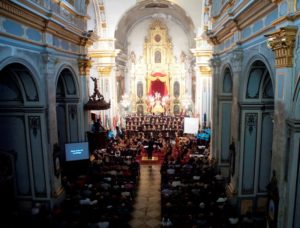José Mª Mompó Bisbal. Notary
The feast of San Jorge brings with it a considerable bustle in the population, a coming of strangers, of absent relatives who take advantage of the circumstance to return to town, that in the bottom of the heart they never left, and incidentally dress up as "festers", actively participating in those April parties, street ornament, decoration of facades, illuminations, etc.
Regarding those, one of the things that attracts the most attention, at least for me it was fictionalized, were the white hangings with the red cross in the center, that many houses place on their balconies. What exact significance could the same? Would, thought, some distinctive of the Christian side that these days ardently confronts the Moor? I asked for. But I was not given an exact answer, or because it was so "old", or because these hangings were easier to do.
Chance, more than anything else, He made a book by Francisco Sevillano Colom fall into my hands on a work from the Centenar de la Ploma in the city of Valencia, citizen militia of the same, also known as Centenar del Glorioso San Jorge, and made up of a hundred crossbowmen who formed the escort of the "Senyera" of the city. Said militia was, as indicated, under the invocation of Saint George, whose red cross, distinctive of the Saint, as we will see later, they wore over the tunic.
First of all, and for those who do not understand our vernacular, let's clarify the title of the article: "The flag of Sant Jordi", whose Castilian translation is that of "The flag or standard of San Jorge".
In the aforementioned book, it is said that the flags or banners of Saint George were widely used in the ancient Crown of Aragon., being its main distinctive the red cross ("Red") of said Santo. Says the author, taking it from the Beuter Chronicle, that in the famous battle of Puig (year 1273) those troops (Aragonese) They carried a flag or signal of the Lord Sant Jordi, and later he adds that Don Guillem de Aguillón, with fifty men on horseback and a thousand armed infantrymen and with a senator from Señor Sant Jordi, he was going along the path of a farmhouse at the south of the Castle. It was precisely in this battle where, according to the tradition, Saint George appeared fighting the enemy.
It remains to be clarified what the Senora de San Jorge was like. The saying author says that of the year 1348 found an unpublished notice of a "senyera" in a delivery note or receipt issued in favor of the royal armourer by in Domingo Novals, by which he recognized that he was owed "per raó … e una senyera de cendat blanch ab creus vermelhas »que hizo en la ciudad de Valencia en el mes de marzo del año escrito (white cloth banner with red crosses).
This distinctive of St. George (white and red crosses) reappears in the Brotherhood of San Jorge de Valencia, created by the King of Valencia Pedro the Ceremonious (year 1371), whose statutes indicate that the brothers, on certain solemnities, they will carry white wax candles with a red cross stamped on them.
Another testimony of the senyera of San Jorge is offered to us by the same image of the Saint, who flies his banner (white flag and red cross).
With the above, the significance of these hangings is clarified., until today half unknown, white with their red cross in the center, to be the flag and banner, best, senyera, of "blessed knight and martyr Saint George", with whose said invocation he was the patron of the named Centenar de la Ploma.
With the same, Our population does nothing other than continue the devotion to Saint George and offer the living testimony of those banners that the Valencians carried through the lands of the infidels.
Bañeres, April 1966.










